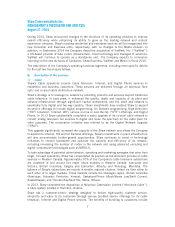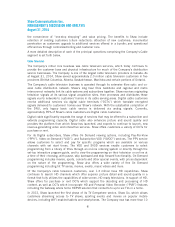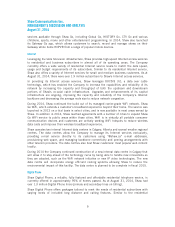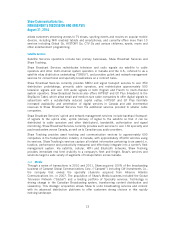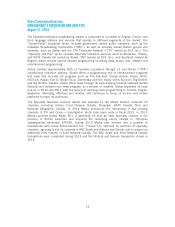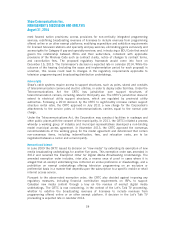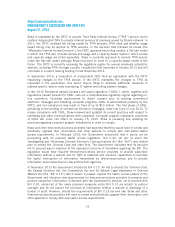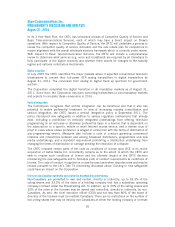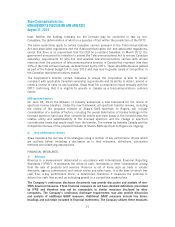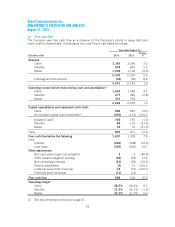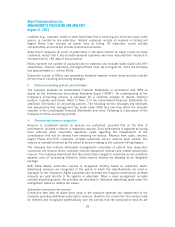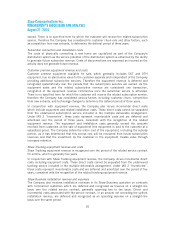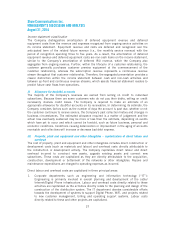Shaw 2014 Annual Report Download - page 21
Download and view the complete annual report
Please find page 21 of the 2014 Shaw annual report below. You can navigate through the pages in the report by either clicking on the pages listed below, or by using the keyword search tool below to find specific information within the annual report.Shaw Communications Inc.
MANAGEMENT’S DISCUSSION AND ANALYSIS
August 31, 2014
inappropriate to maintain the LPIF in the long term and that it would phase out the LPIF over
the two subsequent broadcast years. Accordingly, for the 2012-2013 broadcast year, the LPIF
contribution rate was reduced from 1.5% to 1.0%. For the 2013-2014 broadcast year, the
LPIF contribution rate was further reduced to 0.5%. As of September 2014, the LPIF was
discontinued.
In 2011, pursuant to a change in its policy regarding the delivery of distant signals by licensed
BDUs, the CRTC introduced new Regulations requiring licensed cable BDUs to obtain the
consent of an OTA broadcaster to deliver its signal in a distant market. Pursuant to the
Regulations, DTH distribution undertakings may distribute a local over-the-air television signal
without consent within the province of origin, but must obtain permission to deliver the over-
the-air television signal beyond the province of origin unless the DTH distribution undertaking is
required to carry the signal on its basic service. Broadcasters may assert a right to remuneration
for the distribution of their signals in distant markets on the basis of these Regulations.
Throne Speech and Government Direction
The Speech from the Throne, delivered on October 16, 2013 included a statement indicating
that the Government believes Canadians should have more ability to choose unbundled
television channels, while protecting Canadian jobs. On November 14, the Minister of Canadian
Heritage released an Order-in-Council (“OIC”) requiring the CRTC to report to the Government
by April 30, 2014 on how the ability of Canadian consumers to subscribe to pay and specialty
television services on a service-by-service basis can be maximized, having regard to the
broadcasting and regulatory objectives of the Broadcasting Act as well as specific issues
including the effect of any proposed measures on: consumers with respect to their affordable
access to a variety of services, distribution undertakings, Canadian pay and specialty services
and Canadian independent producers. In addition, the OIC made it clear that any proposed
measures to maximize consumers’ ability to subscribe service-by-service ensure that the
majority of programming services received by subscribers remain Canadian and that Canadian
programming services, particularly local Canadian stations, continue to be given priority. The
CRTC responded to the OIC by reporting that it would reach conclusions on the Government’s
questions in the decision rendered pursuant to a proceeding initially referred to as “a
conversation with Canadians” and later commonly referred to as “Let’s Talk TV”. This
proceeding is described below in more detail. Together, the Government’s articulated position
and the CRTC decision pursuant to the “Let’s Talk TV” hearing could lead to changes in the
regulatory requirements applicable to television programming and broadcasting distribution
undertakings and, in particular, those pertaining to the manner in which the basic service, as
well as packaging and standalone programming service options, are offered to customers.
CRTC Hearing on the Future of Television – Let’s Talk TV
As noted above, on October 24, 2013, the Commission initiated a “conversation with
Canadians about the future of television”, which led to a major review of the regulatory and
policy framework for the Canadian television broadcasting system, during the course of calendar
2014. This proceeding became commonly known as the “Let’s Talk TV” proceeding. The
Commission’s proposals include: a mandatory all-Canadian small basic service; a requirement
to allow subscribers to select all discretionary services on a standalone (pick-and-pay) basis and
build their own custom packages of discretionary programming services (BDUs could still offer
pre-assembled packages); elimination of simultaneous substitution; expansion of the Code of
conduct for commercial arrangements and interactions to prohibit unreasonable penetration-
based rate cards, requirements to distribute a service on the same terms as at a prior date, and
17


